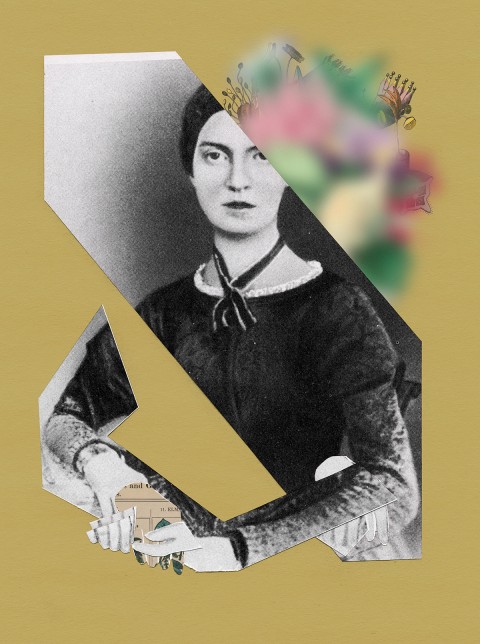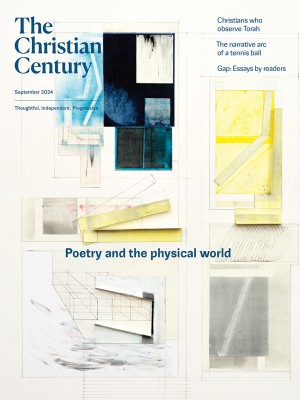
(Illustration by Matt Dorfman)
Even as a nine-year-old, the precocious Emily Dickinson had a special love of botany. To use a technical word like botany might seem a stretch when considering a mere child. But not for this poet-to-be. A fiery fascination lit up her widening glimpses of New England vegetation and bird lore and ground life. Though I’ve read Dickinson and read about her for years, I never knew this—not till I stumbled across Judith Farr’s scholarship and the recently back in print Emily Dickinson Face to Face, a biography by the poet’s niece Martha Dickinson Bianchi. For all my admiration of Dickinson’s vivid images, I didn’t realize how inseparable her writing was from the scenes and sounds of the natural world around her.
Her classroom fascination soon sunk its fingers in real dirt. “My plants grow beautifully,” she announced to a friend at age 11. At 12 she began tending the family garden. And tend she did! Bianchi remembers “carpets of lily-of-the-valley and pansies, platoons of sweet peas, hyacinths enough in May to give all the bees of summer dyspepsia.” That’s not counting the peony hedges and waves of daffodils and “marigolds to distraction—a butterfly utopia.”
Read our latest issue or browse back issues.
More than the sense of sight was enlisted here. Dickinson sowed flowers with special scents, too, writing that she “could inhabit the Spice Isles merely by crossing the dining room to the conservatory, where the plants hang in baskets.” Her “delicious ripe figs,” tricky to grow, received mention in the local paper. She didn’t just plant and prune, either. Over the years she compiled a 66-page leather-bound collection of preserved flowers (an herbarium, it was called). She ended up with 424 pressed flower specimens that she had collected, labeled, and classified.
And she shared the wealth of the earth with family and friends in correspondence that effervesces with vibrancy and wit. Dickinson often sent jotted scraps of her poems with accompanying nosegays—plucked flower bunches, especially the fragrant varieties. So great was her passion for the flourishing of creation’s planted glories that she was, as one friend recalled, more known for her posies than her poems, and in her own day “known more widely as a gardener, perhaps,” by Farr’s reckoning, “than as a poet.”
I can’t help wondering how her tending of God’s good earth gave her practice in tending words, too, as poetic passion and aptitude with words began to blossom.
Lots of us have experiences of nature that stir a feeling in us. But Dickinson became galvanized.
When I, as a kind of pilgrim, visited the Dickinson Homestead in Amherst, Massachusetts, I paid attention mostly to the historic house—especially her second-story bedroom, host to a facsimile of the small desk where she penned her letters and verses. There she retreated, hermit-like, for spans of time, especially when company came calling on other members of the household. She might write or take in the scent of a hyacinth that bloomed on her windowsill in winter.
But the familiar image of a gaunt recluse doesn’t quite hold. Dickinson ranged close and wide in Massachusetts gardens, fields, and orchards. So when I go back to the site, as I hope to, I want even more to look out the window in that room, the window that opened on to what inspired her. I will pay more attention to the glories of nature she could see from her perch: motes of “quiet dust,” frost, a bee at work in the hedges below, a realization that “Hope is the thing with feathers— / That perches in the soul.” (Birds find their way into some 220 of her poems.) And she heard a world of active life that pressed its liveliness onto her senses:
To my quick ear the Leaves—conferred—
The Bushes—they were Bells—
I could not find a Privacy
From Nature’s sentinels—
For even when semi-secluded at home, Dickinson, as one of her close relatives recalled, “would open the window or curtains [of her bedroom] and say poetically what she saw outdoors in the garden or a bird or whatever it was. Emily would ‘talk poetry.’” That scene floors me. She spoke in poems.
That very interweaving of view and word seemed to happen with one of her best-known lines. Dickinson wrote once to a friend and mentor how the “sudden light on Orchards” was one of the glimpses that moved her to write poems, that made her try, she said, to “arrest” such passing phenomena, somehow to capture their essence and meaning with a sharp, clarifying image:
There’s a certain Slant of light,
Winter Afternoons—
That oppresses, like the Heft
Of Cathedral Tunes—
And she tended to the impact and sway such glimpses had on her soul, as she goes on:
Heavenly Hurt, it gives us—
We can find no scar,
But internal difference—
Where the Meanings, are—
She was clasping to herself the meanings out there—poignant, moving, but also ready to be lodged deep in mind and heart, firing the imagination that would budge and animate her pencil.
And then I think, on the other hand, maybe I don’t need to see out her window again. Not when I can look around here and now, out a window in my study in Virginia. Cannot I do that wherever I find myself, as long as I stay alert and awake to emblems of beauty, to tokens of what Dallas Willard called our God-bathed and God-permeated world?
I once heard Andy Crouch, author of books on technology and faith, say that he tries every day—at least for a few minutes—to get outside and look around and look up. I’ve thought of that often, on the days—most days—when I try to do the same. To stand or walk under scudding clouds, to see the majesty of pines and oaks and tulip poplars shielding and ringing my cul-de-sac. To notice the azaleas in our little flower bed in front. To notice even the earthworms and grubs that aerate and forage our soil.
And there’s something more. Lots of us have experiences of nature that stir a feeling in us. But Dickinson became galvanized. What she witnessed compelled her not only to feel but also to well up with words aching with imagery, to grab a pencil stub and an envelope flap or chocolate candy wrapper (where many of her scrawled snatches of verse got netted) and try to express some deeper reverence:
To make a prairie it takes a clover and one bee,
One clover, and a bee.
And revery.
The revery alone will do,
If bees are few.
Revery, yes, but also elation:
Write me how many notes there be
In the new robin’s ecstasy
To plumb immortality, or process her longing for the Divine, or live through grief when death robbed the family of a loved one, she often expressed herself through the material glories of creation: a bird, a dust speck, a moon hung in a night sky, that oft-quoted slant of light. Dickinson’s special genius had to do with making grand ideas vivid with almost granular images, hard realities that sometimes detonate with their depths.
Philosopher H. Martyn Evans writes of wonder as an experience that does more than fill us, it changes us—leading to an “altered, compellingly intensified attention to something that we immediately acknowledge as somehow important.” With the help of Dickinson’s sometimes heart-stabbing images, her beauty-immersed imagination, and her delight in a wider world, we might try to plant ourselves more fully not only in the day here with us but also with an eye to what is to come, as the climate horizon points to a shrinking of species’ variety. As the natural world’s richness wanes, perhaps we will be helped profoundly by a poet’s expansive, animating vision.
For we need people who help us remember our calling as custodians—not just consumers—of the worldly glories around us. And not only cultivators but also reverent keepers. For isn’t part of a poet’s enduring power rooted in her ability to connect us with another world? To turn a “quick ear” to “Nature’s sentinels”? Writers who matter are usually those who see what the rest of us do not and then find ways to make what they notice important to others. Dickinson didn’t want to miss the gorgeousness around her, beauty she personified as though it were a companion she wanted with her in full view through it all:
Beauty crowds me till I die
Beauty mercy have on me
But if I expire today
Let it be in sight of thee—
Might we, with the help of the poets’ high art, make an internal shift—from cooler, utilitarian language to more wonder-laden vocabulary? Tending to things that grow helps us tend to our words and images, too. We learn not just to speak about the goodness of biodiversity but also to let ourselves be moved by a kind of bioluminosity. Not just ecosystem statistics but also staying on the lookout for the eco-incandescence on display every day. Might not environmentalism gain even deeper roots here, in all that comes from a God of inexhaustible creativity? We can make a piece of tillable land a holy ground on which we tread with wider eyes. Or turn toward waters and skies with a more beatified sense of nature’s expansive mysteries.
More than I realized when I first read her poetry, the Belle of Amherst prompts us to ask, What does it mean to live an everyday life surrounded by realities both cosmic and earthy? The lines of her poems and letters can open our imaginations to find more words to keep that wonder alive.






